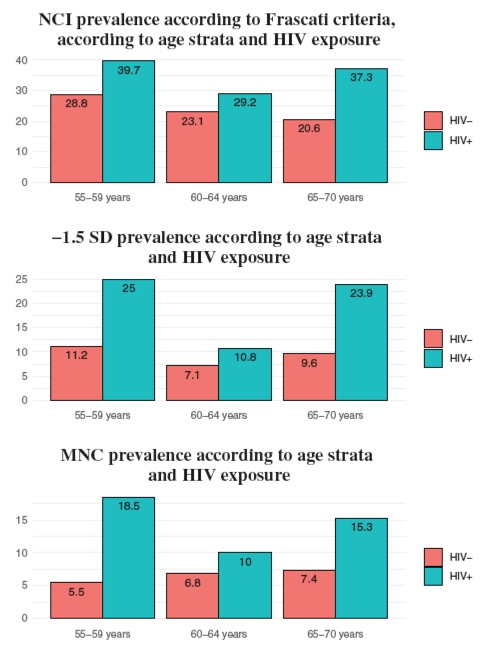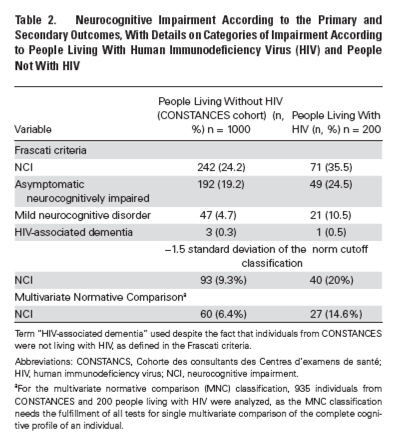| |
HIV & Neurocognitive Impairment - 2 recent studies
|
| |
| |
2 recent studies on HIV & Neurocognitive Impairment: both submitted for publication in 2019. Perhaps the difference in age & maybe nadir CD4 reflected the different findings.
Study # 2: "Our HIV clinics will need to expand services to protect and support these patients appropriately.......Finding a marked increase in neurocognitive impairments in aging PLHIV is a sobering task, and calls health-care providers to prepare additional support and therapy for the associated disability"
1 - No relationship between serostatus and cognitive impairment was found through this study......(average age 38)......Cross-sectional analysis of cognitive function using multivariate normative comparisonsin men with HIV disease
http://www.natap.org/2020/CROI/Cross_sectional_analysis_of_cognitive_function.1.pdf
No relationship between serostatusand cognitive impairment was found through this study. The data reported here replicate and extend priorinvestigations of the relative merits of using MNCmethodologies to determine the rates of impairmentamong individuals with and without HIV disease. Unlikeother studies, we did not find a specific relationshipbetween HIV infection and cognitive impairmentregardless of the methodology utilized [26]. In addition,characteristics of the men as a function of their cognitiveclassification suggests that there may be significant cohortdifferences that may explain the paradoxical observationthat while individuals with AIDS aremorelikely to beimpaired, those who were examined prior to 1996 were less likely to be impaired.
2 - this study below: we found a 74% increased risk of NCI in an aging population of PLHIV( aged 55 to 70 years with controlled viral load with an age, gender, and education matched control population of people not living with HIV, adjusting for a wide variety of confounding factors including behavioral and social factors). This association persisted after adjusting for comorbid and social confounding factors and considering more stringent outcome measures. No interaction between age and HIV status was objectified with any neurocognitive outcome (Table 4).
Increased Prevalence of Neurocognitive Impairment in Aging People Living With Human Immunodeficiency Virus: The ANRS EP58 HAND 55-70 Study - (02/27/20)
RE: regarding Alzheimers, from Commentary below: "Further, there are actually only a very few case reports of documented AD in any HIV patients [4]. These observations should lend hope that the doomsday scenarios around AD in HIV patients are unfounded. Fortunately, tools to predict cognitive impairments with AD are improving rapidly."
• we found a 74% increased risk of NCI in an aging population of PLHIV. This association persisted after adjusting for comorbid and social confounding factors and considering more stringent outcome measures.
• Our HIV clinics will need to expand services to protect and support these patients appropriately.
• Finding a marked increase in neurocognitive impairments in aging PLHIV is a sobering task, and calls health-care providers to prepare additional support and therapy for the associated disability that this population suffers........Recognition that HIV in itself creates a more disabled population with special needs is a call to design care systems to meet the increased needs that this disability brings. This is particularly true given the more isolated living status reflected in the demographics of this population, where more than a third live alone. This isolation not only threatens support systems, but challenges the optimal ways for physicians to recognize, measure, and follow the real impacts of cognitive disabilities.
• The analysis provides hope, while raising realistic concerns that must be addressed in future studies.
• We classified NCI in 71 PLHIV (35.5%) and in 242 controls (24.2%) (OR, 1.74; 95% CI, 1.25-2.41). Most of the 35% were asymptomatic: 24%. There was no indication of worsening NCI as PLWH aged. Two hundred PLHIV were matched with 1000 controls. Median age was 62 years, and 85% were men. In PLHIV, the median T-CD4 lymphocyte level was 650 cells/μL, and median nadir T-CD4 lymphocyte level was 176 cells/μL

No interaction between age and HIV status was objectified with any neurocognitive outcome (Table 4).
The fact that HIV remained associated with cognitive dysfunction in this older group is important......The majority of disabilities identified were asymptomatic or caused only a minor disability: 35% NCI Frascati impaired; ANI-asymptomatic 24%; Mild Neurcognitive impairment 10.5%; HIV-associated dementia 0.5%.

|
|
| |
| |
|
|
|